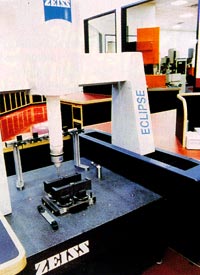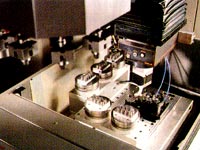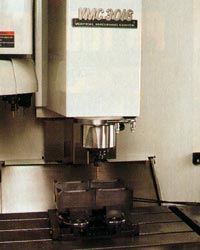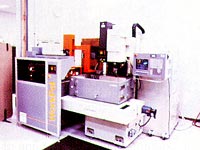By automating just enough of a die-sinker EDM operation, a shop can expand its capability without a major investment in personnel, facilities, or equipment.
With the equipment and systems available, CNC die-sinker EDM users can choose the level of automation they want to invest in and tailor a system that will meet a shop’s needs without profit-draining overkill. The ideal candidate for an upgrade into automation might be a shop currently using CNC EDM machines that expects a surge in business in the near future. For such a firm, adding personnel or expanding its facilities may be out of the question. If so, automation may offer a way to meet future demand by increasing the efficiency and productivity of the shop’s existent resources.
Choosing an appropriate level of automation requires a careful review of a shop’s current capabilities and an assessment of the level of future work that is anticipated. Some of the questions shop managers might consider before choosing an automation system are:
- What will be the average number of parts in each of these future batches?
- What equipment and machines will be used to manufacture the parts?
- How extensively are these machines being used for the current level of work?
- Will any new equipment be required to handle the new work?
- What can be upgraded now and what can be upgraded later?
Simple Beginnings
Even at its most basic level, automation can dramatically improve the productivity of an EDM operation. Many EDM manufacturers offer models with automatic toolchangers (ATCs) included as add-ons. These separate ATC units can sometimes be added to a machine later, but this can be a complicated process if the brackets and electronics for the retrofit have not already been designed. Purchasing a CNC die-sinker machine with an ATC is a relatively simple and common way to upgrade an EDM operation. Any user that must change electrodes several times per cavity will benefit from this purchase. Even users who must change electrodes as often as 6,000 times per month can keep their machines running 90% of the time if their machines are equipped with ATCs.
An ATC employs a fixed or rotating magazine to hold fresh electrodes mounted in holders and an additional mechanism to swap the tools in and out of position on the machine. With the changer’s controller tied into the machine’s controller, tools can be exchanged without operator intervention until the changer runs out of fresh electrodes.
The principle difference between one ATC and another is the number of tools it can load. Users can find ATCs that hold anywhere from 3 to 88 electrodes. A user’s choice of changer will depend on the number of hours the shop plans to operate its EDM unattended. By dividing this goal by the average burn time for each electrode, a shop can determine how many positions its ATC will need.
For instance, a small shop might set 5 to 6 hours of unattended operation as its goal. If each electrode burns for about 1.5 hours, the shop will need a 4-position ATC to meet this goal. A unit of this size will add $8,000 to $12,000 to the price of an EDM. By contrast, a 16-position changer will add about $30,000.
A little math will show how an appropriately sized ATC can pay for itself within months. Let’s say a shop invests an extra $32,000 to purchase an EDM with an ATC. If the shop invoices $50 per hour of EDM work, its billings will equal its investment in about 640 hours of unattended machining time. The ATC makes it possible to accumulate these extra hours quickly. And because these are unattended hours during which the machine would have been idle otherwise, the overhead incurred during this machining time is significantly less than the cost of overhead during normal business hours.

Table 1: Three different toolchanging systems offer a choice of capacities and advantages.
Another factor that will influence a shop’s choice of ATC is the size of the electrodes being changed. Every brand and model of EDM is limited to a certain range of electrode lengths and weights. Units that can use larger electrodes generally can use smaller electrodes as well, but units cannot use electrodes that are larger than the size for which they are designed. Table 1 lists the three types of changers available from System 3R U.S. Inc., Fairfield, NJ, and the electrode sizes they are designed to accommodate. A shop must carefully review its needs and its operations to determine the best combination of tool size and ATC. A tooling representative can offer advice and help purchasers sort through the alternatives available.
Before selecting an ATC, the purchaser also must consider the various changers’ toolchanging times. Even though current EDM processes cannot remove metal as quickly as milling or turning, EDM’s metal-removal rates are improving continually. As the burn time of each electrode becomes shorter, the time it takes for the ATC to change tools becomes more critical. ATCs typically change tools in about 45 sec. Some specially designed systems can swap tools in about 25 sec.
Presetting Is the Next Step
With toolchanging automated, a shop seeking further gains in productivity might upgrade its workhandling equipment and procedures. A system that can change parts quickly and efficiently will have the greatest impact in applications that require relatively short total burn times. As a first step on the path to workholding automation, operators might prepare work outside the EDM while another job is running. When the first job ends, the preset job can be loaded into the machine with little downtime. The 10 or 20 minutes it typically takes to set up the job is spent off the machine.
The operators actually may be able to set up offline faster than on the machine. Presetting stations can be in locations that are cleaner and more convenient than the machine’s work envelope, thus eliminating the time operators typically have to spend cleaning parts and chucks or reaching for tools.
Presetting workpieces for die-sinker EDM requires a presetting station equipped with the same chuck as the EDM. Repeatability from chuck to chuck is crucial. High-precision operations demand accuracies within 0.0001".

Figure 1: A CMM located at the presetting station can record vital information about workpieces and electrodes prior to an EDM operation.

Figure 2: With a gripper claw loaded into its c-axis, this EDM is able to move parts into position from magazines located around its work area.

Figure 3: This VMC is equipped with chucks that allow multiple electrodes to be machined.

Figure 4: This die-sinker EDM is linked to a free-standing 16-station workpiece changer.
The economic justification for a presetting station will depend on the amount of time operators are spending aligning their work in the tank of the machine. If they are changing work three or four times a day, a shop may find that the increased machine uptime will more than compensate for its investment in a common chucking system. Where the cost can be justified, the setup process can be further automated with the addition of a CMM to determine offset values (Figure 1).
A machine’s ATC, working in concert with its c-axis and a special attachment, offers further opportunities for workhandling automation. This submersible system works with preset parts loaded into magazines set just outside the machine’s working area. The magazines are essentially simple racks that hold the parts until the EDM is ready to machine them. The position of each part loaded into the magazines is programmed into the EDM’s CNC.
While the EDM is burning a part, the special attachment, which looks like a U-shaped claw, sits in one of the ATC’s slots. This gripper claw is designed to fit into the machine’s c-axis the way an electrode does. When the time comes to change parts, the ATC replaces the tool in the c-axis with the gripper claw. The EDM then moves the c-axis into a position that allows the claw to grip the OD of the finished part’s pallet. With additional movement of the c-axis, the pallet is removed from the pneumatically operated chuck on the table and placed back in its original magazine position. The gripper claw is then moved to the next magazine position to retrieve another workpiece and move it to the chuck. With the workpiece exchange complete, the claw is replaced with a fresh electrode in the c-axis and the EDM is ready to begin work on the new part (Figure 2).
This type of simple automation system lends itself to workpieces that fit on pallets measuring 4" or less in diameter. A typical system will have room for five to eight magazine positions. For the claw to properly mate with the pallet, parts must be placed in the magazine within ±0.002" of the programmed location. The claw places the part in the chuck with the same degree of accuracy. The chuck then automatically locates the work with a higher degree of precision when it closes.
The major advantage of a simple system like this is its relatively low cost. The table chuck, magazines, claw, and accessories together cost $20,000 to $25,000. This is a minor investment compared to the $80,000 to $500,000 a shop might spend on a fully automated system. The claw system can’t be implemented on every machine, however. The c-axis must be strong enough to turn with an offset weight hanging from the claw.
This same system can be used with a milling machine to automate the machining of electrodes (Figure 3). One user who has outfitted his 5-axis machining center with the components is now able to make more than 100 electrodes and prototypes per day.
Stand-Alone Workhandlers
To automate the EDMing of larger parts or to EDM more than eight parts unattended, a shop will need to go a step beyond a simple gripper-claw system. Fortunately, advances in design and technology have made units with higher capacities available at a cost that smaller shops can afford. For less than $50,000, a shop can purchase a free-standing workpiece changer that has space for up to 16 pallets, each weighing up to 44 lb.
Such a unit is designed to stand next to and work with a die-sinker EDM outfitted with an automatic chuck (Figure 4). Workpieces are exchanged on a command from the EDM’s CNC. Like the simpler claw system, this workpiece changer also can be configured for use with wire EDMs, mills, or grinders. Automatic chucks are available for all of these machines, including low-profile chucks for wire EDMs with fixed zero-line tables. Where machines with removable tables are used, a shop might consider building a new table with built-in chucks. This would allow an operator to change the whole table or parts of the table automatically.
In more sophisticated systems, sensors integrated into the chucks can be used to determine if the work is properly aligned. These sensors can detect changes in the pressurized air used to clear reference surfaces. The pressure values are compared to preset ranges, and if the reading falls outside the range, an alarm is sounded or the machine may automatically attempt to reclamp the part.
Computer-Based Integration
Once a shop’s separate functions are automated, the next step is the integration of these functions with a computer-based system that manages work preparation and work flow. These systems, which typically employ software running on high-end PCs, allow operators and managers to trace a part’s progress through the shop. By consulting the system a manager could, for example, see if the set of electrodes needed for a specific customer’s mold are on time. The software also lets managers make or change priorities or create databases that hold such information as offset values, job numbers, material, accuracies, drawings, or quality-assurance procedures. Almost any piece of information an operator or manager might want to associate with one specific electrode or workpiece can be stored in the database and used later for analysis.
Any stored data can be accessed wherever there is a terminal. A company might want four or five terminals in the shop for use by foremen, operators, work preparation personnel, and quality engineers. Work- and toolhandling equipment tied into the computer network can also access this data. Information such as the offset of the tool or part can be read directly by the changer, and any commands for x- or y-axis movements to compensate for this offset can be issued automatically by the computer. The changer also can read general information from the database to know which job is actually in the machine. Information about machine maintenance, electrode wear, and other vital shop statistics can be kept in the database as well. Managers who trace costs with such a system can more accurately quote jobs. They also can track quality-control data to monitor shop-floor performance.
Full-scale automation is not the only option for EDM shops that want to increase their capacity without expanding their facilities or workforce. There are several reasonably priced options that can increase efficiency and machine utilization. Should a shop need greater capacity or a more sophisticated system in the future, these systems can be upgraded and integrated to create a full-scale automated work- and toolhandling system. Before implementing any system, a shop must determine what benefits it might derive from the various levels and types of automation systems available and choose the system that will give it the quickest return on its investment.
About the Author
Anders Utterstrom is regional sales manager for System 3R U.S. Inc., Fairfield, NJ.
Related Glossary Terms
- burning
burning
Rotary tool that removes hard or soft materials similar to a rotary file. A bur’s teeth, or flutes, have a negative rake.
- chuck
chuck
Workholding device that affixes to a mill, lathe or drill-press spindle. It holds a tool or workpiece by one end, allowing it to be rotated. May also be fitted to the machine table to hold a workpiece. Two or more adjustable jaws actually hold the tool or part. May be actuated manually, pneumatically, hydraulically or electrically. See collet.
- computer numerical control ( CNC)
computer numerical control ( CNC)
Microprocessor-based controller dedicated to a machine tool that permits the creation or modification of parts. Programmed numerical control activates the machine’s servos and spindle drives and controls the various machining operations. See DNC, direct numerical control; NC, numerical control.
- electrical-discharge machining ( EDM)
electrical-discharge machining ( EDM)
Process that vaporizes conductive materials by controlled application of pulsed electrical current that flows between a workpiece and electrode (tool) in a dielectric fluid. Permits machining shapes to tight accuracies without the internal stresses conventional machining often generates. Useful in diemaking.
- gang cutting ( milling)
gang cutting ( milling)
Machining with several cutters mounted on a single arbor, generally for simultaneous cutting.
- machining center
machining center
CNC machine tool capable of drilling, reaming, tapping, milling and boring. Normally comes with an automatic toolchanger. See automatic toolchanger.
- milling
milling
Machining operation in which metal or other material is removed by applying power to a rotating cutter. In vertical milling, the cutting tool is mounted vertically on the spindle. In horizontal milling, the cutting tool is mounted horizontally, either directly on the spindle or on an arbor. Horizontal milling is further broken down into conventional milling, where the cutter rotates opposite the direction of feed, or “up” into the workpiece; and climb milling, where the cutter rotates in the direction of feed, or “down” into the workpiece. Milling operations include plane or surface milling, endmilling, facemilling, angle milling, form milling and profiling.
- milling machine ( mill)
milling machine ( mill)
Runs endmills and arbor-mounted milling cutters. Features include a head with a spindle that drives the cutters; a column, knee and table that provide motion in the three Cartesian axes; and a base that supports the components and houses the cutting-fluid pump and reservoir. The work is mounted on the table and fed into the rotating cutter or endmill to accomplish the milling steps; vertical milling machines also feed endmills into the work by means of a spindle-mounted quill. Models range from small manual machines to big bed-type and duplex mills. All take one of three basic forms: vertical, horizontal or convertible horizontal/vertical. Vertical machines may be knee-type (the table is mounted on a knee that can be elevated) or bed-type (the table is securely supported and only moves horizontally). In general, horizontal machines are bigger and more powerful, while vertical machines are lighter but more versatile and easier to set up and operate.
- outer diameter ( OD)
outer diameter ( OD)
Dimension that defines the exterior diameter of a cylindrical or round part. See ID, inner diameter.
- turning
turning
Workpiece is held in a chuck, mounted on a face plate or secured between centers and rotated while a cutting tool, normally a single-point tool, is fed into it along its periphery or across its end or face. Takes the form of straight turning (cutting along the periphery of the workpiece); taper turning (creating a taper); step turning (turning different-size diameters on the same work); chamfering (beveling an edge or shoulder); facing (cutting on an end); turning threads (usually external but can be internal); roughing (high-volume metal removal); and finishing (final light cuts). Performed on lathes, turning centers, chucking machines, automatic screw machines and similar machines.
- work envelope
work envelope
Cube, sphere, cylinder or other physical space within which the cutting tool is capable of reaching.
